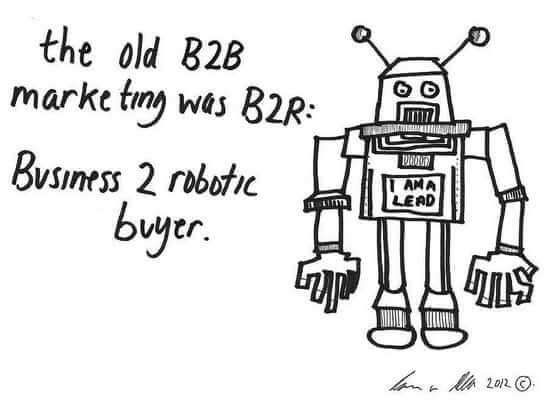The way that consumers arrive at a purchasing decision has changed. For the first time in history, the buyer holds all of the cards. They have the power to conduct their own research, explore their options, and build perceptions – and all that happens before they even speak with a supplier or sales person. Since the decision making process has changed, B2B marketing and sales departments need to change or they’ll be left in the dust.
What proof is there that this B2B buying process shift is taking place?
A report by the Corporate Executive Board surveyed over 1,400 B2B customers and found that 57% of the typical purchase decision is made before a customer even talks to a supplier.
This statistic shows that the game has changed. In the old days, a sales rep held all of the cards; they were the go-to source for information. They could then align their different product offers according to how they thought it best aligned with the needs of their prospects.
Today there is a different type of buyer on the other end of the phone. It is a buyer that has done their research, understands their options, and is looking for a solution that provides the most value to their life. The question now becomes, how do you respond?
1. Create content on a website optimized for conversion
This new type of buyer conducts their research online. They go to Google or ask a question inside a LinkedIn group. Their decisions are made based on educational content and trusted advisors.
To add value to this process you need an inbound marketing strategy that generates quality content on a consistent basis. This strategy can be structured in campaigns where each campaign has a core content offer that functions as a lead magnet.
Components of the inbound marketing campaign, like blog posts, emails, press releases, or social updates, need to point the reader toward the content offer. The “landing page” or “squeeze page” for that offer provides the opportunity for a reader to convert into a lead in your marketing database.
2. Nurture prospects based on target personas
A prospect may download content, but that doesn’t mean that they’re ready to speak with sales just yet. They’re still conducting their research, searching for content that will help them make the most educated decision possible. It’s time to nurture them with email messages that share additional helpful content with them. The whole goal is to give the prospect all the information they need to make an educated decision.
If you’re going to deliver the most relevant information to your prospect, your database needs to be well-segmented. One key element to include on every form on your website is a field that identifies the lead’s persona type. This can be as simple as a drop-down field that lists “Best Describes Me” options that you’ve pre-defined.
With an understanding of your prospect’s persona and a record of their download activity and website engagement, you can effectively begin to deliver lead nurturing emails that are personalized based on their persona and history. Any marketing software worth their salt will allow you to perform this functionality. My all-time favorite is HubSpot.
3. Be consultative in your sales approach
Once you have attracted a lead with valuable content, nurtured with additional information, and tracked their interaction with your content, it’s time for someone from your team to reach out.
It’s so important to know the difference between this new buyer and the old buyer. As a salesperson, you’re now approaching a prospect who is armed with knowledge. They know about the competition, they know about best practices, but they need help putting it all together.
They need someone who is an expert who can help them construct the custom solution that is right for their needs. This is the role of the modern sales person. Successful salespeople are as good at listening and helping as they are at talking and closing.
This is also where a close alignment between sales and marketing can be incredibly valuable. A sales person can look at data from the marketing software to understand the interests of a prospect based on the content they have downloaded. They can then reach out on social networks or through email to personally recommend additional content and provide themselves as a resource for the decision making process.
Cartoon by Kenny Madden



